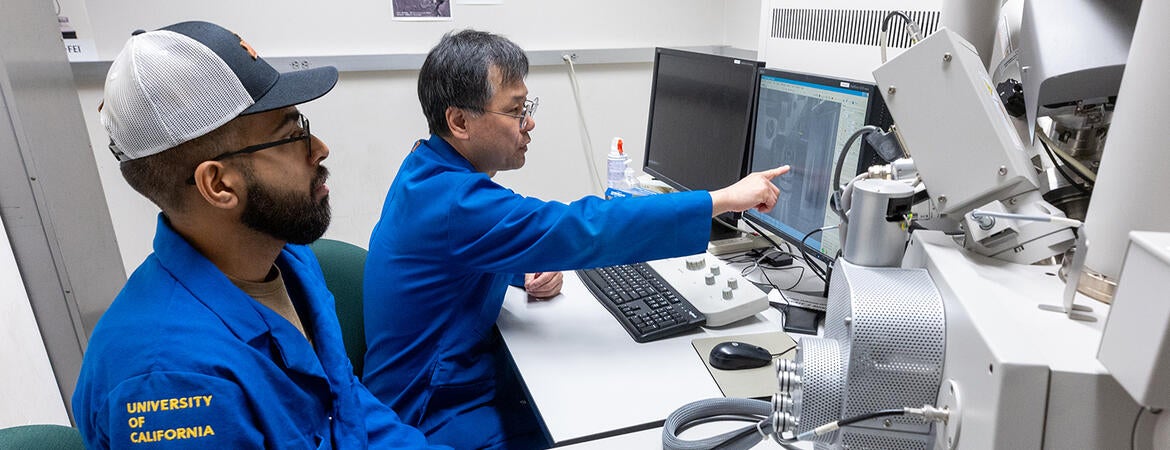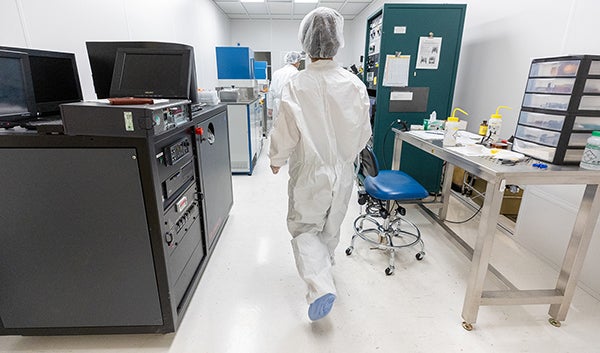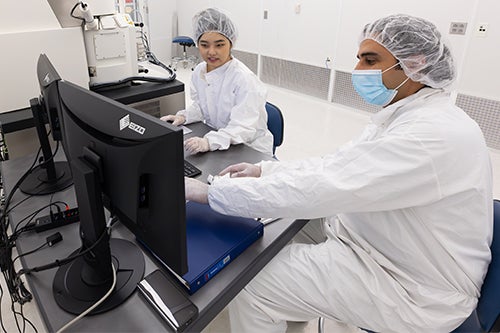
UC Riverside is advancing innovation and economic development by combining two highly specialized laboratories on campus. The initiative will expand access and capabilities for academic researchers as well as private sector users, including those working to commercialize UCR innovations.
The new laboratory will be formed by merging the existing Nanofabrication Facility with the Central Facility for Advanced Microscopy and Microanalysis, or CFAMM. The new facility will have greater research capacity through an investment of earlier campus allocations of about $3 million for new equipment, explained Shane Cybart, associate professor of electrical and computer engineering and director of UCR division of the California Institute for Telecommunications and Information Technology (Calit2), which will manage the new facility.
The merged nanofabrication and electron microscopy facility will eliminate duplication and competition between the two facilities, Cybart said. Housed in the basement area of the Materials Science and Engineering building, the merge will be seamless regarding the equipment that is already up and running, while additions are expected to be completed in about a year.
UCR researchers in medicine, plant sciences, physics, agriculture, and computer science and electronics, among other disciplines, will continue to benefit from state-of-the-art research facilities. A battery of ceiling HEPA air filters keeps the air in the “clean rooms” of the lab void of dust, pollen, and other common airborne particulate matter necessary for the fabrication of computer and electronic components at the nano level.
“We have a new laser lithography system that allows researchers to go in and directly write circuits for rapid prototyping,” Cybart said. “And we have also added an electron beam lithography system that lets you create structures down to eight nanometers. That is only about 15 atoms!” (A nanometer is one billionth of a meter.)
The lab also has equipment for the microscopic characterization of organic and inorganic materials, biological tissue, and minerals that utilize electron beam techniques. This equipment includes electron microscopes that utilize scanning, transmission, and focused ion beam technologies important for research in the life sciences.
Under the administration of UCR’s Office of Research and Economic Development, the lab will also be accessible to entrepreneurs working to commercialize UCR’s scientific innovations and high-tech companies in need of state-of-the-art facilities for training and product development.
By creating synergy between academia, emerging biotech, and high-tech industries, the university stands to enhance its reputation nationally and gain financially by attracting new grants and contracts and earning royalties from UCR innovations that achieve commercial success, explained Rodolfo Torres, UCR’s vice chancellor for research and economic development and a distinguished professor of mathematics. An industry-accessible laboratory is also expected to boost the Inland Empire economy by making the region more attractive to biotech and high-tech firms.
“The facilities give UCR great opportunities for research and training in a very specialized way, particularly in the cleanroom facility. This is much needed in the computer chip industry,” Torres said. “You can provide students with the training demanded by high-tech companies like Intel.”
Fees charged for lab use, combined with investments from UCR’s Office of Research and Economic Development will be used the sustain the lab, Torres said. In the short term, the Office of the Provost, the Bourns College of Engineering, and the College of Natural & Agricultural Sciences will also contribute financial support, but these funds are to be phased out as the new facility becomes financially sustainable.
The new unit will be a boost for UCR-Calit2, which is a multidisciplinary institute for academic and industry researchers jointly run by UCR, UC Irvine, and UC San Diego. It is one of the four California Institutes for Science & Innovation, established by the Governor's office on UC campuses, to address major research questions requiring multidisciplinary approaches and sophisticated instrumentation. UCR joined Calit2 in 2022. Researchers associated with the three campuses have access to all three laboratories, which avoids the duplication of costly equipment and other resources.
“It doesn't make sense for UCR to buy a $2 million machine for one person, when UC Irvine or UC San Diego may already have it. In contrast, UCR has a lot of specialty equipment that the others don't have, so there is a great synergy,” Cybart said.
“We are confident that our efforts will new bring capabilities to the Inland Empire and ensure our community of students, faculty and local businesses have a seat at the table in the nation’s push for advancing domestic microelectronics manufacturing and research,” Cybart added.
Header photo: Ilkeun Lee shows PhD student Sourabh Ramakkrishna how to operate a scanning electron microscope in the Nanofabrication Facility, at the Bourns College of Engineering, on March 19, 2024. (UCR/Stan Lim)







